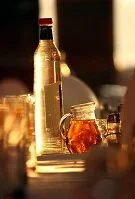If you're dining in public, the host is expected to pay for the entire bill. If you're not the host, don't offer to pay though since this can be very rude; instead invite your host to dinner at a later date.
At sit down restaurants with a waiter or waitress, round up or tip about 10% of the bill.
Drinks

Rakija
Due to a past under both Austrian and Turkish rule, Serbia has grown quite fond of coffee, particularly strong dark Turkish coffees. The country is also known for tits mineral waters. If neither of these sound appetizing, Serbia also has juices, tea, coffee, soft drinks, and milk widely available.
While beer, wine, and hard liquors are also common in Serbia, they have two local specialties: sljivovica, which is a distilled plum juice and rakija, which is distilled from grapes.
Generally speaking, the tap water is safe to drink in Serbia, but check with locals for any particular regional differences. Also, many people may have troubles adjusting to the local tap water, as it will most certainly be different from what your system is used to.